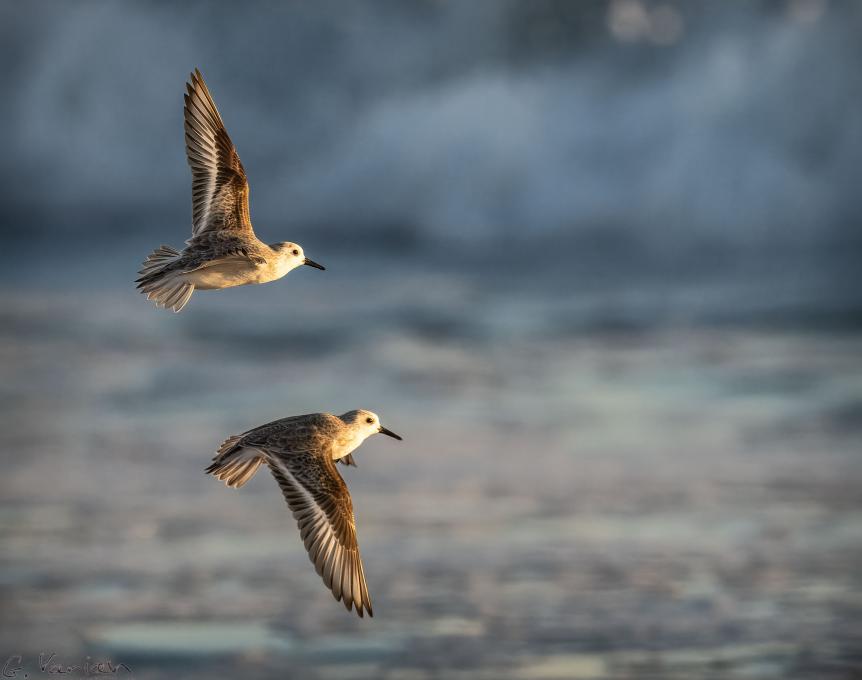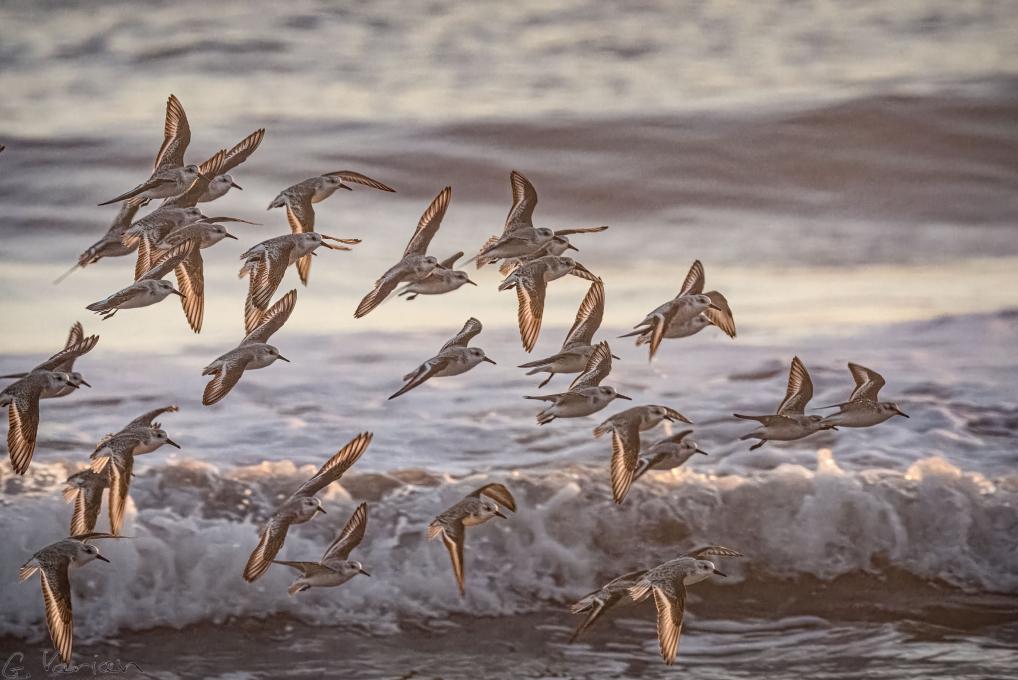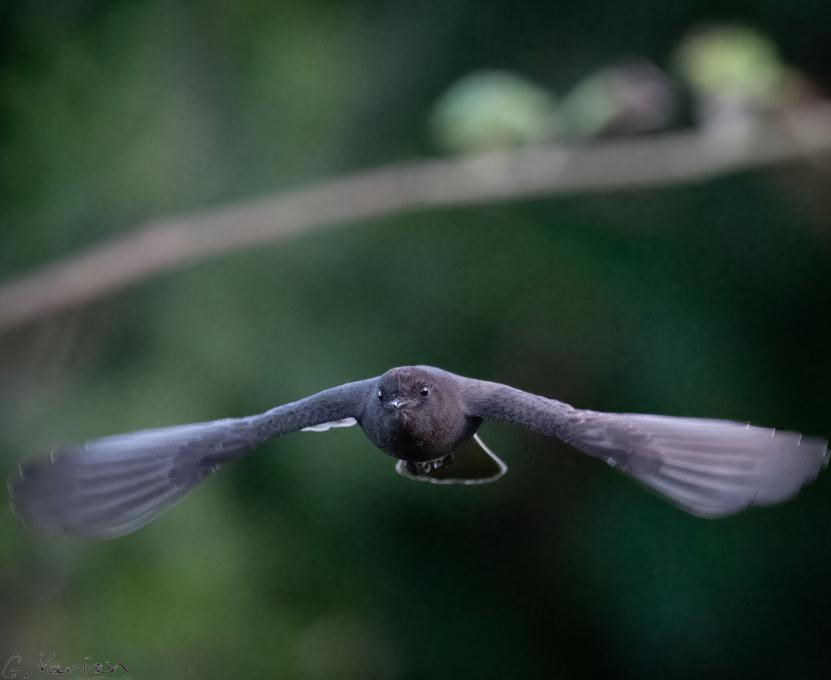George
Forum Replies Created
Viewing 5 posts - 1 through 5 (of 5 total)
-
GeorgeParticipantI went to the beach near my house in Santa Cruz CA just before sunset. The was a flock of over 100 sanderlings and I positioned myself so that they were front lit as they ran in and out with the waves. When they were disturbed by a dog they flew past me on the ocean side at eye level. giving me opportunity to photograph front lit, side lit, and back lit. This happened more than once so I was able to try different camera settings. The first and third were shot at 1/1000 at F18 while the second was shot at 1/2000 at F8. Stopping down from my usual wide open 600mm F4 helps to capture the whole flock but also shows the ocean context. Next time I will try 1/1000 at F11. De-noising was applied.


 in reply to: Practice Capturing Birds in Flight #989618
in reply to: Practice Capturing Birds in Flight #989618 -
GeorgeParticipantI went out to shot Black Phoebes hunting. I decided not to try to time the shot at takeoff but to burst shoot at the perched bird at 10 fps until he flies. This gives me less than 4 minutes on the card and sometimes the bird just sits there. This bird was too close to be able to track when he flew, but was so beautifully perched I went for it anyway. When the bird flew he came strait toward me so tracking was easy and I got a bug's eye view of a Phoebe on the hunt.


 in reply to: Practice Getting Creative and Telling Stories #987880
in reply to: Practice Getting Creative and Telling Stories #987880 -
GeorgeParticipantThese two photos were shot in February when I favored square format and are part of my "post a bird daily" project that I started in January.
 This was shot using the rule of thirds. The image is full frame cropped to square. The birds eye and is 1/3 in from the lower left. The following shot was also originally rule of thirds.
This was shot using the rule of thirds. The image is full frame cropped to square. The birds eye and is 1/3 in from the lower left. The following shot was also originally rule of thirds.
 In the detail cropping the obscured eye looks at the viewer from dead center.
Both were shot at 600mm, F4, 1/1250, ISO Auto in reply to: Practice Crafting Great Bird Photos #986239
In the detail cropping the obscured eye looks at the viewer from dead center.
Both were shot at 600mm, F4, 1/1250, ISO Auto in reply to: Practice Crafting Great Bird Photos #986239 -
GeorgeParticipant
 At the senior residence in Oakland where I live, there is a small garden with a decorative fountain. I just sit in a comfortable chair and wait for the birds to come. A few days ago a Western Bluebird family, two adults and three juveniles came to bathe. The last to bathe was the male who ended his bath with this flourish. in reply to: Practice Gaining an Audience with Birds #986148
At the senior residence in Oakland where I live, there is a small garden with a decorative fountain. I just sit in a comfortable chair and wait for the birds to come. A few days ago a Western Bluebird family, two adults and three juveniles came to bathe. The last to bathe was the male who ended his bath with this flourish. in reply to: Practice Gaining an Audience with Birds #986148 -
GeorgeParticipantIn choosing a bird to study up on I rejected several because they didn't breed locally. I chose the Black Phoebe since it stays in my part of California all year and is an easy bird to find. That said it is not an easy bird to photograph because I want the bird in flight catching an insect. The good thing about the Phoebe is that they take off from a perch, fly out, catch a bug and return to the same perch if I don't ge too close. That way I get many opportunities. To get sharp images I find 1/4000 works best. To keep noise in control I shoot wide open, F4 so focus is critical. The other challenge is that if I get too close I can’t keep the bird in frame when it takes off so most shots get cropped to 1/4 picture width. Birds of the World states that they prefer perches 1 to 1.5 meters off the ground. It is easier to follow a bird that is perching higher, so I planted some 1.5 bamboo stakes in the marsh where the background was favorable. I saw 3 Phoebes while doing this. The next two days I checked for Phoebes several times and saw none which is unusual. Thinking that they a wider perch I made one from a piece of driftwood. Then I noticed a pair perched on a pipe under the bridge. The book says they separate in the fall but I have seen them flying together though they hunt separately. Checking the 800 phoebe pictures that I have kept since January, I can confirm that they molt in July and August as the book says. They sure did look shabby. Regrettably I was away from April to June and missed the breeding season. I guess this little bird is going to be running my life.
 in reply to: Practice Understanding Birds for Better Photos #985590
in reply to: Practice Understanding Birds for Better Photos #985590
Viewing 5 posts - 1 through 5 (of 5 total)






 This was shot using the rule of thirds. The image is full frame cropped to square. The birds eye and is 1/3 in from the lower left. The following shot was also originally rule of thirds.
This was shot using the rule of thirds. The image is full frame cropped to square. The birds eye and is 1/3 in from the lower left. The following shot was also originally rule of thirds.
 In the detail cropping the obscured eye looks at the viewer from dead center.
Both were shot at 600mm, F4, 1/1250, ISO Auto
In the detail cropping the obscured eye looks at the viewer from dead center.
Both were shot at 600mm, F4, 1/1250, ISO Auto  At the senior residence in Oakland where I live, there is a small garden with a decorative fountain. I just sit in a comfortable chair and wait for the birds to come. A few days ago a Western Bluebird family, two adults and three juveniles came to bathe. The last to bathe was the male who ended his bath with this flourish.
At the senior residence in Oakland where I live, there is a small garden with a decorative fountain. I just sit in a comfortable chair and wait for the birds to come. A few days ago a Western Bluebird family, two adults and three juveniles came to bathe. The last to bathe was the male who ended his bath with this flourish. 